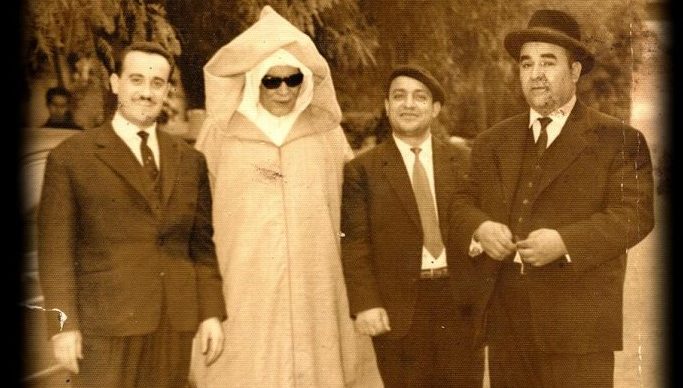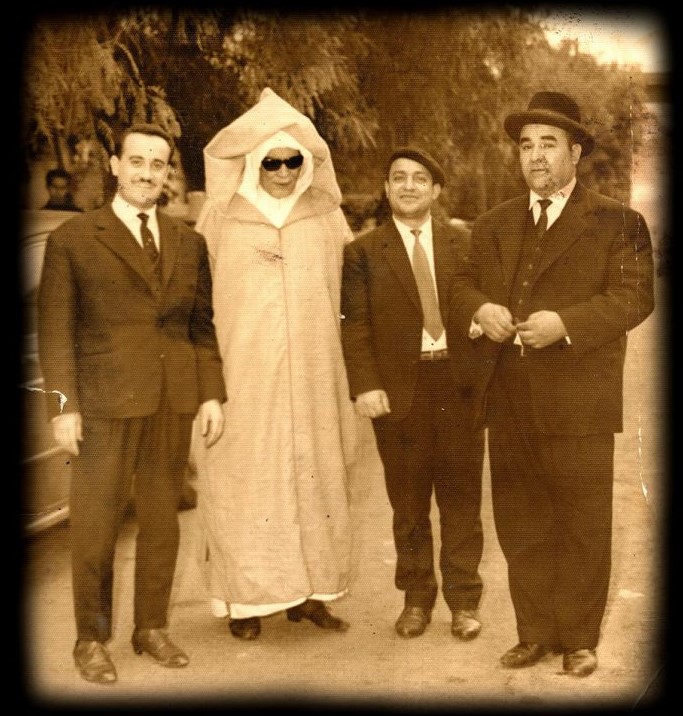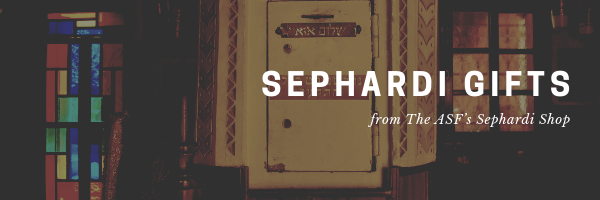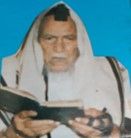
“In Memory of Mordechai Ben-Porat, A”H, the 98-year-old Baghdad-born Jew, who was one of the instrumental masterminds of the covert operations (Ezra and Nehemiah) that rescued 130,000 Jewish refugees from Iraq after denationalization (1950-1951). A veteran of the War of Independence, Ben-Porat was a past Member & Deputy Speaker in the Knesset, Minister without portfolio, Head of the Or Yahuda Council. His affection for Iraqi Jewish history and traditions was second to none. Through his characteristic perseverance, he successfully founded and securely established the Babylonian Jewish Heritage Center in Israel – a wonderful museum about Jewish life throughout history in what is now known as Iraq, securing the memory of this important and ancient community. He was its chairman for many years until only a few years ago. Ben-Porat was also the inspiration that led to the creation of the World Organization of the Jews from Iraq. He was a recipient of the Israel Prize for “Lifetime Achievement and Special Contribution to Society and the State.” In spite of his high age, he remembered and remained in contact with all his supporters for the Babylonian Jewish Heritage Center till the very last days of his life.” ~David Dangoor, President of the American Sephardi Federation
Click here to dedicate a future issue in honor or memory of a loved one

The American Sephardi Federation’s Sephardi Ideas Monthly is a continuing series of essays and interviews from the rich, multi-dimensional world of Sephardi thought and culture that is delivered to your inbox every month.
Previous issues of Sephardi Ideas Monthly explored the rise of Israel’s Piyyut movement, one of the most profound and fascinating developments in Israeli culture, and Jewish culture in general, in recent decades. North African and Middle Eastern piyyutim—songs from the genre of liturgical soul music—were transformed into material and inspiration for Israeli artists, while the organized public singing of piyyutim became an opportunity for all kinds of Jews (men and women; young and old; secular, traditional, and religious; Ashkenazi and Sephardi) to gather and musically connect to the tradition. An encyclopedic website, “Invitation to Piyyut,” was established in 2005 that opened up the world of piyyutim to the general public (today’s it’s operated through the website of Israel’s National Library) and popular piyyut festivals began to be organized in 2007. In 2010, The New Jerusalem Orchestra opened the Israel Festival with a jazz-infused extension and elaboration of mostly Andalusian piyyutim that was even celebrated by the National Jazz Museum in Harlem, and in 2018, the state of Israel recognized the Israeli Andalusian Orchestra, Ashdod, as a national orchestra on par with the Israel Philharmonic Orchestra.
This societal-cultural marvel raises a question. Where were these piyyutim, some of whose melodies date back to the 18th century and whose texts sometimes stretch all the way back, via inventive recasting of familiar Biblical verses, 3000 years, before they burst into Israel’s public sphere?
One main source for the preservation and development of piyyutim is the North African and Middle Eastern tradition of communal gathering before sunrise on Shabbat to sing baqqashot—”songs of seeking,” in Edwin Seroussi’s wonderful translation. Many of the piyyutim that can be heard on the radio and in Israel’s public sphere were carried in the heart, minds, prayerbooks, and special songbooks of North African and Middle Eastern olim (new immigrants) who continued the Shabbat tradition of baqqashot in peripheral towns and cities like Dimona, Sderot, Ofaqim, and Beit Shean, as well as larger cities like Ashdod and Jerusalem. In some places, the tradition continues today. This month’s issue of Sephardi Ideas Monthly provides a fascinating and accessible overview of the two main traditions of baqqashot—the Jerusalem-Sephardi style, and the Moroccan style—with an introductory article from Hebrew University’s Jewish Music Research Centre, an extremely rich online source of recordings and information.
As for the origin of the baqqashot tradition:
The baqqashot as we know them today originated among cabbalistic circles in Safed in the sixteenth century. The cabbalists of Safed ascribed prime importance to the singing of piyyutim.

(Photo courtesy of Rafael Balulu/A Song of Loves)
The Safed composers and singers of piyyutim channeled the “poets of the so-called ‘Golden Age’ of Hebrew poetry in Spain (10th to 13th centuries)” together with “piyyutim written by Sephardi poets, many of them cabbalists, in the Land of Israel and the neighboring countries from the sixteenth century onwards. The most prominent among them was Rabbi Israel Najara.”
Najara’s piyyutim were collected in a songbook called Zemirot Yisra’el, a collection that is remarkable for many reasons, including “that the piyyutim are arranged according to the maqamat (musical modes) in use in the court music of the Ottoman Empire.” The adoption of these modes shaped the subsequent development of the Jerusalem-Sephardi tradition:
The adoption of the maqam principle as the basis of the religious music of the Sephardi Jews in the Ottoman Empire, from the sixteenth century until now, led to the crystallization of liturgical traditions and piyyut performances that conform to this musical system. The most common of these liturgical styles (is) known as the Jerusalem-Sephardi style.
Following the collapse of the Ottoman empire and the rise of Arab-Islamic political-cultural centers in the late 19th and early 20th centuries, the Jerusalem-Sephardi style began to incorporate Arabic musical modes on top of the older stratum of Turkish ones. As for the Moroccan tradition:
The main difference between the Moroccan baqqashot and those of the east is that in the Moroccan tradition, each of the 22 Sabbaths in which the baqqashot are performed has its own repertoire of piyyutim.
The sources of the baqqashot piyyutim’s melodies vary, but most of them come from the Arabic-Andalusian tradition, with some eastern and even European influences. However, there are also unique baqqashot melodies. Older sources of the baqqashot are melodies from the 17th and 18th century that were set to ancient piyyutim.
Because there are different piyyutim for each Shabbat, the amount of musical material is immense, and the vast Moroccan collection of baqqashot served as the original repertoire of the Israel Andalusian Orchestra, Ashdod, when it was founded in the early 90s. However, preserving that rich tradition wasn’t so simple:
Due to the immigration of the majority of Moroccan Jews to Israel, and the difficulties of assimilation in the new country, the Moroccan baqqashot practice, like other parts of the Moroccan Jewish tradition, suffered a decline during the 20th century.
One man, however, played an outsized role in keeping the tradition alive:
Rabbi David Buzaglo, who immigrated to Israel in 1965, [did] immense work in order to revive the Moroccan Jewish traditions, including the singing of baqqashot.
Read the article “Baqqashah (Pl. Baqqashot)“
Sephardi Ideas Monthly is delighted to introduce our readers to the beautiful Jerusalem-Sephardi and Moroccan baqqashot traditions, and in so doing to provide a deeper, richer perspective on the amazing rise of Israel’s piyyut movement.
~~~~~~~

The American Sephardi Federation invites all individuals, communities, and organizations who share our vision & principles to join us in signing the American Sephardi Leadership Statement!
Please also support the ASF with a generous, year-end tax-deductible contribution so we can continue to cultivate and advocate, preserve and promote, as well as educate and empower!
Make checks payable to “American Sephardi Federation” @ 15 West 16th Street, New York, NY, 10011.
Email us at info@americansephardi.org if you are interested in discussing donating securities or planned giving options with a financial professional from AllianceBernstein.
~~~~~~~
The Monthly Sage החכם החודשי
The sage for the month of January is Hakham Menini Bitan.
Menini Bitan was born in Zarzis, Tunisia, in 1886. A gifted student, he joined his father in the jewelry craft after completing his studies. However, after noticing the difficulty of students still in school, he began to work as a teacher. Hakham Menini Bitan’s care for the community extended to the children whom he would assemble in the synagogue on Hol Hamo’ed, intermediary holy days when they were customarily on holiday, to sing piyuttim, in keeping with Tunisian Jewish tradition.
In 1956, Hakham Menini Bitan made Aliyah with his wife, Bakhla, settling near Beit Shemesh before moving to Safed to assume leadership of the local Tunisian-Jewish community. He undertook all the religious tasks for the community, but remained a learned yet modest scholar, known for behaving in a simple and unassuming manner. He set up a special matzah bakery before Passover to prepare the hand-made matzoth that were customarily used by Tunisian Jews.
Hakham Menini Bitan passed away on 23 Kislev, 1986, and was buried in Safed. Most of his writing was kept in manuscript form in the Alush Homani synagogue in Safed where, unfortunately, accumulated moisture rendered the texts unreadable. Some of Hakham Menini’s original commentary, recounted by his students, appears in a book, Ish Eshkolot (“Many-sided Man”), published in his memory.
In the following passage from Ish Eshkolot, Hakham Menini recalls the Tunisian custom of reciting celebratory Hallel psalms while baking matzah for Passover:
The women in [the] room knead the dough, and so that they not tarry, request help from the boys, who pour water for them on the dough in order to speed up the kneading. Immediately after, they pass the dough to the men leaning over the tables and the person standing at the head of the table distributes the dough to them. The kneading by the men begins immediately, and they break out in jubilant song, reading the Hallel with great joy and outstanding devotion. Once the matzah takes its form, the boys make holes in them and those standing bring the matzoth to the bakery as quickly as possible, to prevent its leavening, to observe “and they could not tarry”. The singing of Hallel echoes between the bakery walls during the entire time the matzoth are being prepared and can be heard from afar.
~~~~~~~

Pizmonim: Sephardic-Hebrew Songs of the Middle East, Volume 1
By David Elihu Cohen
Pizmonim, a unity of poetry and song, have been an integral part of the Jewish People and may be traced in the Bible to the very beginning of our history.
The twelve selected Pizmonim contained in this booklet serve to perpetuate the Greater Sephardic culture and tradition of singing praise to the Lord on all joyous occasions.
By Rabbi Abraham Lopes Cardozo
Encouraged by many friends who wanted to preserve our beautiful Spanish-Portuguese musical tradition, Abraham Lopes Cardozo published Selected Sephardic Chants. This publication afforded him an opportunity to include some little known tunes of the Tish’a Be-Ab services, both evening and morning, blessings for Haftarah.
Four books of the Bible, the Song of Songs, Ruth, Lamentations, and Esther, are read as part of the Synagogue service during the year: Passover, Shabuoth, Tish’a Be-Ab, and Purim. The excerpts included in this edition are recited at the conclusion of the weekday-morning service and Shabbath afternoons, several days before the particular holiday. They are recited when a mourner is present who is obliged to recite the Kaddish
~~~~~~~
Upcoming Events or Opportunities
The Jews of Italy and the African Empire
This project examines the causes, nature, and consequences of Italian Jews’ support for imperialism. I argue that between the 1890s and 1930s, Italian Jews took an active part in racializing and controlling indigenous Libyan and Ethiopian Jews. Moreover, by promoting the empire and upholding a racial hierarchy between Europeans and Africans, Italian Jews unwittingly contributed to their own downfall, since Italy’s antisemitic campaign (1938-1945) borrowed heavily from earlier anti-black legislation and propaganda.
This book breaks new ground; using non-traditional sources, it is the first study to inquire what ordinary European Jewish women and men thought about empire and how they engaged with it in their daily life. The Italian case is uniquely fertile for examining the relationship between Jews and race; Italy’s forays into Eritrea, Somalia, and Ethiopia, home to the Beta Israel, triggered the earliest significant encounter between white Jews and sub-Saharan black Jews. As such, Jews and Race also speaks to emerging interest in the history of Jews of color and broadens the study of intra-Jewish racism.
Tuesday, 1 February at 12:00PM EST
Sign-up Now!

About the Speaker:
Dr. Shira Klein is Associate Professor of History at Chapman University. She has won awards from the Memorial Foundation for Jewish Culture, the Yad Hanadiv/Beracha Foundation, and the USC Shoah Foundation.
Sponsorship opportunities available:
info@americansephardi.org
===
The ASF Institute of Jewish Experience presents:
New Works Wednesday with Dina Danon
Join us for a New Works Wednesday with Dr. Dina Danon who will be discussing her book The Jews of Ottoman Izmir: A Modern History (Stanford University Press, 2020), a finalist for the National Jewish Book Award in Sephardic Culture.
Wednesday, 2 February at 12:00PM EST
Sign-up Now!

About the book:
This lecture will tell the story of a long-overlooked Ottoman Jewish community in the late nineteenth and early twentieth centuries. Drawing extensively on a rich body of previously untapped Ladino archival material, the lecture will also offer a new read on Jewish modernity. Across Europe, Jews were often confronted with the notion that their religious and cultural distinctiveness was somehow incompatible with the modern age. Yet the view from Ottoman Izmir invites a different approach: what happens when Jewish difference is totally unremarkable? What happens when there is no “Jewish Question?” Through the voices of beggars on the street and mercantile elites, shoe-shiners and newspaper editors, rabbis and housewives, this lecture will underscore how it was new attitudes to poverty and social class, not Judaism, that most significantly framed this Sephardi community’s encounter with the modern age.
About the author:
Dina Danon is Associate Professor of Judaic Studies at Binghamton University. She holds a doctorate in History from Stanford University. She is the author of She was recently a fellow at the Katz Center for Judaic Studies at the University of Pennsylvania, where she began work on a new project on the marketplace of matchmaking, marriage, and divorce in the eastern Sephardi diaspora. She is currently at work, with Nancy Berg, on a co-edited volume entitled Longing and Belonging: Jews and Muslims in the Modern Age.
For here more about the book.
Sponsorship opportunities available:
info@americansephardi.org
===
The ASF Institute of Jewish Experience presents:
The Jew who Ruled Persia: The Story of Sa’ad ad-Dawla
Sa’ad ad-Dawla was a Persian Jew from the city of Abhar. Being a master in recovering delayed taxes, he was able to rise in the ranks of the Mongol Ilkhanate that ruled all of Persia and Iraq. He had personal interactions with Ilkhan Arğun, where he demonstrated a strong compunction against corruption, a facility with languages, knowledge about minute matters throughout the lands, and the ability to cure the Ilkhan of disease. The led to Arğun appointing him as the Grand Vizier of the Ilkhanate in 1289, the most powerful position in the country below the Ilkhan himself. Despite the offense that many Muslims took to having a Jew in such a position of power, the Buddhist Arğun defended him and gave him a long leash to improve the Ilkhanate.
Sunday, 6 February at 12:00PM EST
Sign-up Now!
Complimentary RSVP
(Please consider a suggested donation of $10: https://tinyurl.com/DonateASFIJE)

About the Speaker:
Richard Sassoon is an Iraqi-American of Jewish heritage who graduated from Georgetown University’s School of Foreign Service and Fordham University Law School with a J.D. and with an LL.M. in European Business Law from Madrid’s Universidad Pontificia Comillas. He currently works at UnitedLex as a Contract Manager, but has previously held roles at Samsung Engineering, J.P. Morgan, and several law firms. Richard sits on the ASF Young Leaders Board and is a recipient of the ASF Broome & Allen Fellowship. Richard has a long-standing interest in diverse cultures and regions, having visited over fifty different countries, meeting various high-level diplomats with Jewish organizations, working on three continents, and handling legal documents in five languages.
Sponsorship opportunities available:
info@americansephardi.org

